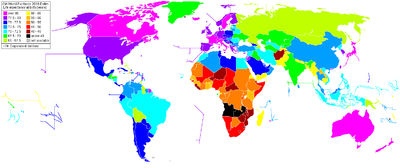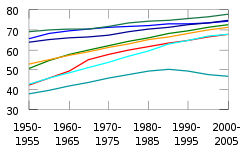
Measuring poverty
Encyclopedia




Poverty
Poverty is the lack of a certain amount of material possessions or money. Absolute poverty or destitution is inability to afford basic human needs, which commonly includes clean and fresh water, nutrition, health care, education, clothing and shelter. About 1.7 billion people are estimated to live...
is in the developing world, there is evidence of poverty in every region. In developed countries, this condition results in wandering homeless
Homelessness
Homelessness describes the condition of people without a regular dwelling. People who are homeless are unable or unwilling to acquire and maintain regular, safe, and adequate housing, or lack "fixed, regular, and adequate night-time residence." The legal definition of "homeless" varies from country...
people and poor suburbs and ghetto
Ghetto
A ghetto is a section of a city predominantly occupied by a group who live there, especially because of social, economic, or legal issues.The term was originally used in Venice to describe the area where Jews were compelled to live. The term now refers to an overcrowded urban area often associated...
s. Poverty may be seen as the collective condition of poor people, or of poor groups, and in this sense entire nation-states
Nation
A nation may refer to a community of people who share a common language, culture, ethnicity, descent, and/or history. In this definition, a nation has no physical borders. However, it can also refer to people who share a common territory and government irrespective of their ethnic make-up...
are sometimes regarded as poor. To avoid stigma these nations are usually called developing nations.
Absolute vs relative poverty
When measured, poverty may be absolute or relative poverty. Absolute poverty refers to a set standard which is consistent over time and between countries. An example of an absolute measurement would be the percentage of the population eating less food than is required to sustain the human body (approximately 2000-2500 calories per day).Relative poverty, in contrast, views poverty as socially defined and dependent on social context. One relative measurement would be to compare the total wealth of the poorest one-third of the population with the total wealth of richest 1% of the population. In this case, the number of people counted as poor could increase while their income rise. There are several different income inequality metrics
Income inequality metrics
The concept of inequality is distinct from that of poverty and fairness. Income inequality metrics or income distribution metrics are used by social scientists to measure the distribution of income, and economic inequality among the participants in a particular economy, such as that of a specific...
, one example is the Gini coefficient
Gini coefficient
The Gini coefficient is a measure of statistical dispersion developed by the Italian statistician and sociologist Corrado Gini and published in his 1912 paper "Variability and Mutability" ....
.
Measurements
The main poverty line used in the OECD and the European UnionEuropean Union
The European Union is an economic and political union of 27 independent member states which are located primarily in Europe. The EU traces its origins from the European Coal and Steel Community and the European Economic Community , formed by six countries in 1958...
is a relative poverty measure based on "economic distance", a level of income usually set at 60% of the median household income http://www.poverty.org.uk/summary/eapn.shtml
The United States, in contrast, uses an absolute poverty measure. The US poverty line was created in 1963-64 and was based on the dollar costs of the U.S. Department of Agriculture's "economy food plan" multiplied by a factor of three. The multiplier was based on research showing that food costs then accounted for about one third of the total money income. This one-time calculation has since been annually updated for inflation.
The US line has been critiqued as being either too high or too low. For example, the Heritage Foundation
Heritage Foundation
The Heritage Foundation is a conservative American think tank based in Washington, D.C. Heritage's stated mission is to "formulate and promote conservative public policies based on the principles of free enterprise, limited government, individual freedom, traditional American values, and a strong...
, a conservative U.S. think tank
Think tank
A think tank is an organization that conducts research and engages in advocacy in areas such as social policy, political strategy, economics, military, and technology issues. Most think tanks are non-profit organizations, which some countries such as the United States and Canada provide with tax...
, objects to the fact that, according to the U.S. Census Bureau, 46% of those defined as being in poverty in the U.S. own their own home (with the average poor person's home having three bedrooms, with one and a half baths, and a garage).. Others, such as economist Ellen Frank, argue that the poverty measure is too low as families spend much less of their total budget on food than they did when the measure was established in the 1950s. Further, federal poverty statistics do not account for the widely varying regional differences in non-food costs such as housing, transport, and utilities.
Both absolute and relative poverty measures are usually based on a person's yearly income and frequently take no account of total wealth. Some people argue that this ignores a key component of economic well-being.
Definitions
The World BankWorld Bank Group
The World Bank Group is a family of five international organizations that makes leveraged loans, generally to poor countries.The Bank came into formal existence on 27 December 1945 following international ratification of the Bretton Woods agreements, which emerged from the United Nations Monetary...
defines poverty in absolute terms. The bank defines extreme poverty
Extreme poverty
Extreme poverty, as defined in 1996 by Joseph Wresinski, the founder of ATD Fourth World, is:"The lack of basic security connotes the absence of one or more factors enabling individuals and families to assume basic responsibilities and to enjoy fundamental rights. The situation may become...
as living on less than US$1.25 per day (PPP
Purchasing power parity
In economics, purchasing power parity is a condition between countries where an amount of money has the same purchasing power in different countries. The prices of the goods between the countries would only reflect the exchange rates...
), and moderate poverty as less than $2 a day. It has been estimated that in 2008, 1.4 billion people had consumption levels below US$1.25 a day and 2.7 billion lived on less than $2 a day. The proportion of the developing world's population living in extreme economic poverty has fallen from 28 percent in 1990 to 21 percent in 2001. Much of the improvement has occurred in East and South Asia. In Sub-Saharan Africa GDP/capita shrank with 14 percent and extreme poverty increased from 41 percent in 1981 to 46 percent in 2001. Other regions have seen little or no change. In the early 1990s the transition economies of Europe and Central Asia experienced a sharp drop in income. Poverty rates rose to 6 percent at the end of the decade before beginning to recede. There are various criticisms of these measurements.
Non-monetary indicators
Some economists such as Guy Pfeffermann say that other non-monetary indicators of "absolute poverty" are also improving. Life expectancyLife expectancy
Life expectancy is the expected number of years of life remaining at a given age. It is denoted by ex, which means the average number of subsequent years of life for someone now aged x, according to a particular mortality experience...
has greatly increased in the developing world since WWII
World War II
World War II, or the Second World War , was a global conflict lasting from 1939 to 1945, involving most of the world's nations—including all of the great powers—eventually forming two opposing military alliances: the Allies and the Axis...
and is starting to close the gap to the developed world where the improvement has been smaller. Even in Sub-Saharan Africa, the least developed region, life expectancy increased from 30 years before World War II to a peak of about 50 years before the HIV pandemic and other diseases started to force it down to the current level of 47 years. Child mortality
Child mortality
Child mortality, also known as under-5 mortality, refers to the death of infants and children under the age of five. In 2010, 7.6 million children under five died , down from 8.1 million in 2009, 8.8 million in 2008, and 12.4 million in 1990. About half of child deaths occur in Africa....
has decreased in every developing region of the world. The proportion of the world's population living in countries where per-capita food supplies are less than 2,200 calorie
Calorie
The calorie is a pre-SI metric unit of energy. It was first defined by Nicolas Clément in 1824 as a unit of heat, entering French and English dictionaries between 1841 and 1867. In most fields its use is archaic, having been replaced by the SI unit of energy, the joule...
s (9,200 kilojoules) per day decreased from 56% in the mid-1960s to below 10% by the 1990s. Between 1950 and 1999, global literacy increased from 52% to 81% of the world. Women made up much of the gap: Female literacy as a percentage of male literacy has increased from 59% in 1970 to 80% in 2000. The percentage of children not in the labor force has also risen to over 90% in 2000 from 76% in 1960. There are similar trends for electric power, cars, radios, and telephones per capita, as well as the proportion of the population with access to clean water.
Income inequality
Income inequality for the world as a whole is diminishing. A 2002 study by Xavier Sala-i-MartinXavier Sala-i-Martin
Xavier Sala-i-Martin is a professor of economics at Columbia University.Sala-i-Martin earned his degree from the Autonomous University of Barcelona in 1985 and his Ph.D. from Harvard University in 1990, both in economics...
finds that this is driven mainly, but not fully, by the extraordinary growth rate of the incomes of the 1.2 billion Chinese citizens. However, unless Africa achieves economic growth, then China, India, the OECD and the rest of the middle-income and rich countries will diverge away from it, and global inequality will rise. Thus, the economic growth of the African continent should be the priority of anyone concerned with decreasing global income inequality.
Poverty Gap Index The mean distance below the poverty line as a proportion of the poverty line where the mean is taken over the whole population, counting the non-poor as having zero poverty gap.
Stats
Even if poverty may be lessening for the world as a whole, it continues to be an enormous problem:- One third of deaths - some 18 million people a year or 50,000 per day - are due to poverty-related causes. That's 270 million people since 1990, the majority women and children, roughly equal to the population of the US.
- Every year nearly 11 million children die before their fifth birthday.
- In 2001, 1.1 billion people had consumption levels below $1 a day and 2.7 billion lived on less than $2 a day
- 800 million people go to bed hungry every day.
Other factors
The World Bank's "Voices of the Poor" , based on research with over 20,000 poor people in 23 countries, identifies a range of factors which poor people consider elements of poverty. Most important are those necessary for material well-being, especially food. Many others relate to social rather than material issues.- precarious livelihoods
- excluded locations
- gender relationships
- problems in social relationships
- lack of security
- abuse by those in power
- dis-empowering institutions
- limited capabilities, and
- weak community organizations.

